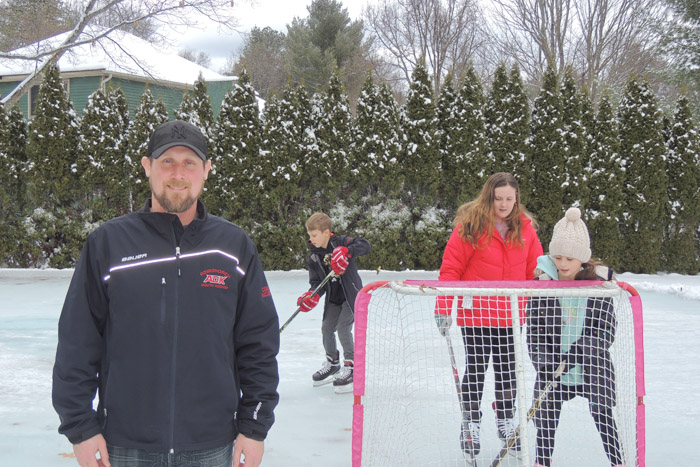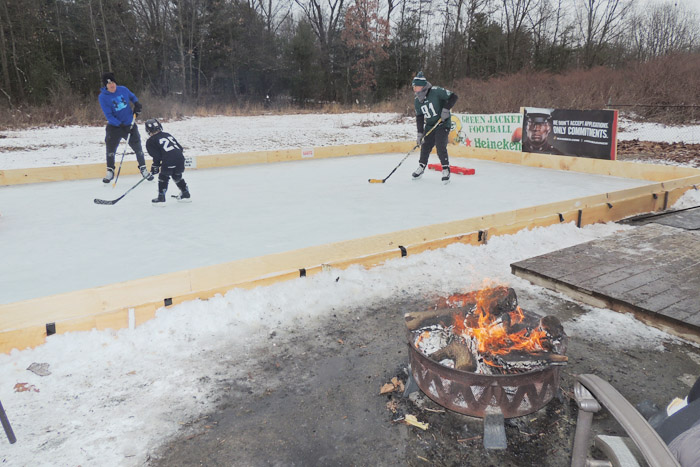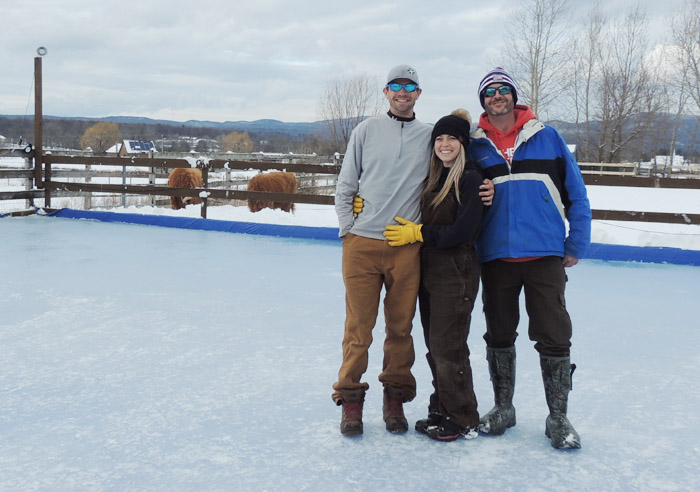By Gordon Woodworth, Chronicle News Editor
“It’s like having another kid,” Jason McCann says of his backyard skating rink in Queensbury.

“You have to baby it. I’m constantly watching the weather forecast. When it snows, after working a 10-hour day, you’ve got to come home and not only snowblow your driveway, but then snowblow the ice.
“It’s a lot of work but a ton of fun. When you skate, it’s all worth it, especially if you have kids.”
Even with this winter’s fluky winter weather, backyard ice rinks are in use and very popular. We talked to three people who have them to find out what it takes to build them and how to maintain them.
Todd Ramsey of South Glens Falls said he built a backyard ice rink this year because his six-year-old grandson Rowen plays hockey. “And it’s a nice way to get the family together during the winter,” he said. He’s got a firepit next to his 24-by-35-foot rink, and board signs too.

Grant Krogmann of Kingsbury fenced off part of a corral at his girlfriend Nikki Becker’s farm; their curious Scottish Highland cattle Caley and Rainey watch their every move. He’s got lights on his 76-by-45-foot rink, but says they aren’t really needed on a clear night. “Out here, with no street lights, you can still see,” he said.

The first step to building a backyard rink is to level off the ground. All three men said you’re never going to get it completely level, but the more level it is, the more even the ice will be.
Then you need lumber to ring the rink. Most use 2-by-10-inch or 1-by-10-inch wood for the perimeter, screwing or nailing it in place.
“The hardest part is getting everything square,” Mr. McCann said. He had a co-worker and neighbor, Ben Didio, help in exchange for unlimited use of his 36-by-50-foot surface.
Then you need a big sheet of heavy-duty plastic, which costs $200 or more. Lay in the plastic, secure it to the inside of the boards, and either staple it in or put a smaller piece of lumber over it and nail it.
All that’s needed now is a cold snap and a good hose. “Once you get the initial ice, it stays,” Mr. Ramsey said.
Mr. Krogmann said your initial ice surface should be at least six inches thick.
As the ice sets, watch out for falling leaves. “You wouldn’t believe the damage they can do,” Mr. McCann said.
He said they melt right down through the ice on sunny days, so he uses a blow torch to get them off the ice as much as he can.
If it snows, all three men said to get the snow off as quickly as possible. Some use snowblowers. Others use a shovel.
After clearing the ice, flood it again when it’s below 32 degrees.
Mr. McCann acknowledges, “It’s never going to be completely smooth.
“You’ve got to work with the weather, but it’s all pretty easy,” Mr. Ramsey said. “When it’s nice, we’re out here all day.”
He’s even thinking about having a broomball tournament for his buddies.
“It’s something to get you out of the house,” he said.
Mr. Krogmann says he skates “as much as I can.”
Nikki Becker said Mr. Krogmann was skating “every morning and every night for a week. He’s always out here.”
Mr. McCann said his son Lucas, 9, and daughter Alexa, 11, love to skate.
Lucas plays travel hockey and hones his skills whenever he can.
“And there are a lot of kids in the neighborhood who come over,” Mr. McCann said. “I’m going to get a fire pit. Sometimes we have 15 kids here.”
Mr. McCann said a backyard ice rink fulfills a lifelong goal.
“As a kid, I always wanted one,” he said.
Mr. Krogmann played youth hockey growing up, and he said his father, retired Judge David Krogmann, and a half-dozen other families had backyard rinks.
Copyright © 2020 Lone Oak Publishing Co., Inc. All Rights Reserved.
 Glens Falls Chronicle Serving the Glens Falls/Lake George region; Warren, Washington and northern Saratoga counties since 1980
Glens Falls Chronicle Serving the Glens Falls/Lake George region; Warren, Washington and northern Saratoga counties since 1980


